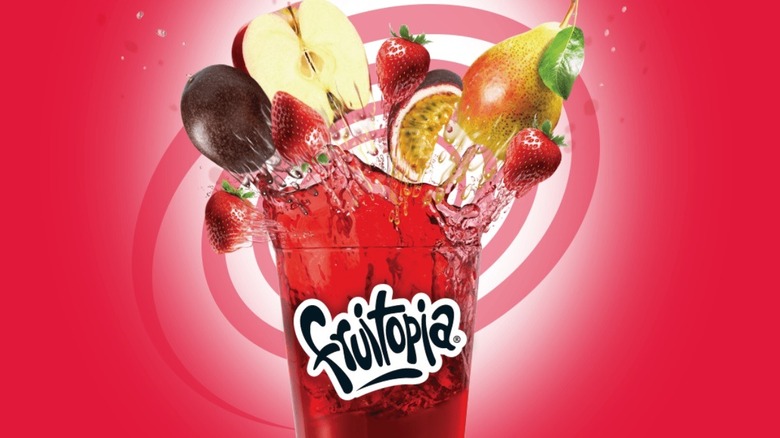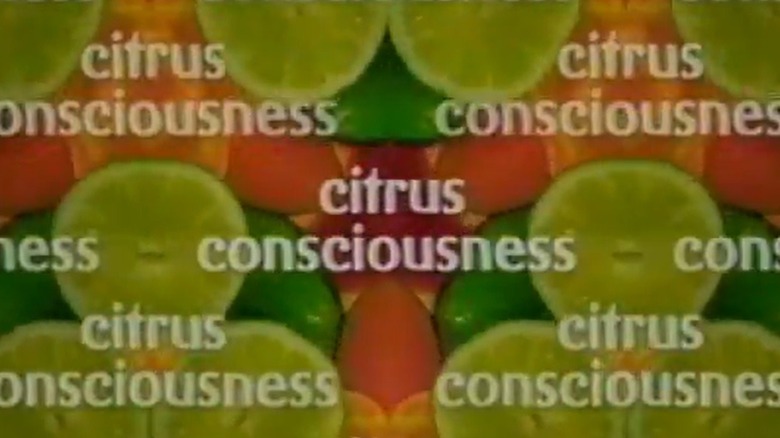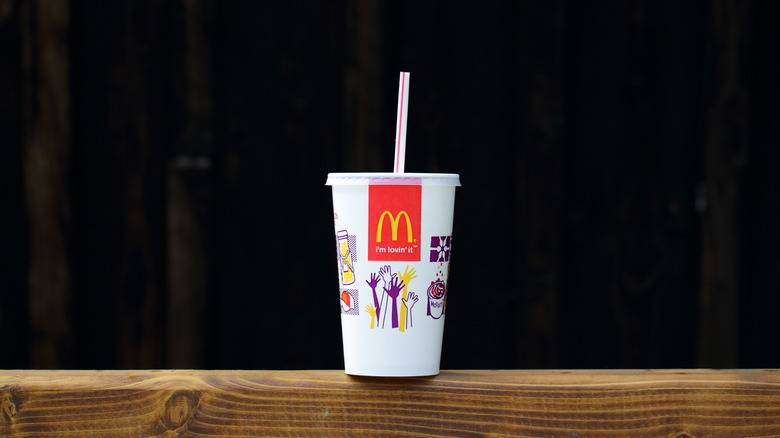Here's What Really Happened To Fruitopia
Forget Dunkaroos and Oreo O's cereal. We can't talk about nostalgic treats without mentioning Fruitopia. You might recognize it from your childhood, or more recently from the soda machine at your local McDonald's, but believe it or not Fruitopia used to be a standalone bottled beverage. Whatever happened to it?
For some clarity on the mysterious Fruitopia lore, Atlas Obscura — the unofficial authority on all places and things that exist on the fringes of the universe, or that have been lost to the sands of time — offers answers. The beverage, it says, was released by Coke in 1994, with a $30 million advertising effort to emulate fruity soda-alternatives like Snapple.
Snapple had taken off in the 1990s. The Washington Post reported that when Quaker bought Snapple in 1994 (the same year as Fruitopia's launch), the company's sales had reached a peak: $670 million. The non-carbonated fruit drink business was booming and, for a while, at least, Coke's efforts worked, too: TIME magazine hailed Fruitopia as one of the 10 best new products of 1994. But, with such a popular launch, where did this fan-favorite fruit fare disappear to?
A drink for the rest of us
Fruitopia sprang like the goddess Athena from the forehead of Sergio Zyman, former marketing chief at Coca-Cola and the mind behind Coca-Cola flavors like Diet Coke and Cherry Coke, per Ad Age. In 1994, Zyman described Fruitopia as, "the first truly global launching of an alternative product," (via the Tampa Bay Times). Part of the company's $30 million campaign for Fruitopia included commissioning experimental musician Kate Bush to write music for a series of nearly 10 Fruitopia commercials (like this 1994 one for the Fruit Integration flavor, featuring a kaleidoscopic trip of psychedelic shapes against a '60s color palette). The beverage also boasted a commercial with music written by influential art rock band the Cocteau Twins — the song was aptly titled "Fruitopia."
Zyman committed to the aesthetic. As part of the marketing campaign of Fruitopia's initial launch, Coke sent out an armada of teenagers in colorfully painted school buses a la Ken Kesey to hand out free bottles of the drink around the country, per Atlas Obscura. A 1994 article by the Los Angeles Times reported that Fruitopia was clearly marketed at younger audiences from the start.
Further, as Atlas Obscura notes, labels like "strawberry" or "orange" couldn't keep up with the raw trail-blazing heat of Fruitopia, which instead featured iconoclastic names like Grape Beyond and Citrus Consciousness. Instead of adopting the catchy, marketable slogan of any other corporate-sellout beverage in the vending machine, Fruitopia offered proverbs: "If your mouth can't say something nice, put something nice in it," it proclaimed, or "Lemonade, love, and hope — ⅔ appear in the Old Testament."
Which way to the Fruitopia, nowadays?
In 2003, Coca-Cola announced plans to phase out Fruitopia from the U.S. market, instead absorbing four of the bestselling flavors into its Minute Maid line, per Supermarket News. Bevmark president Tom Pirko said of Fruitopia at the time, "There was nothing wrong with the product, but it wasn't that exciting," via the news outlet. He maintained that Minute Maid had more sustainable long-term market power as an already-established, trusted household brand name. Coke spokesperson Ray Crockett had agreed with Pirko's assessment, but also added that it was ultimately "hard to say" why Fruitopia didn't enjoy the same commercial success as its rivals like Snapple (via Supermarket News).
But, even after a long and winding road, Fruitopia remains an unwavering beacon of all-natural ideology. The drink was unveiled by Coca-Cola, with the mission of "embod[ying] free-spirit and harmony. The fruits of your imagination!" Take a sip, Coke says, and you'll be imbued with "the inspiration to unleash your full imagination." All for the price of a medium (who are we kidding — large) soft drink at McDonald's.
That's right, the fast-food chain/global cultural glue still currently carries Fruitopia flavors Strawberry Passion Awareness and Orange Groove in many of its soda dispensers in Canada (whereas U.S. consumers are more likely to find Minute Maid's Strawberry Punch). The non-carbonated drink also remains available to purchase in stores in Canada and Australia (via Google Arts & Culture). Fruitopia has also accrued something of an underground cult following: There are even petitions on Change.org to bring the drink back to the U.S. market. In proper new age form, the dream lives on.


